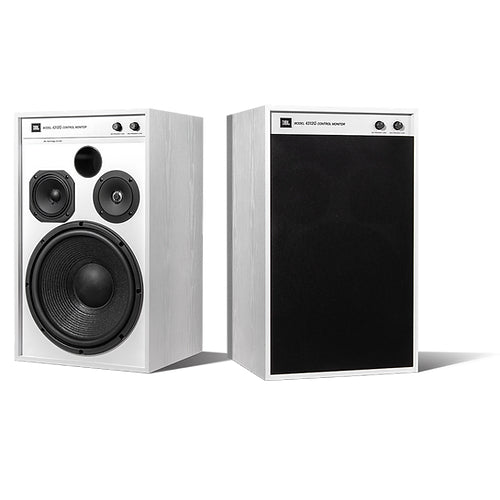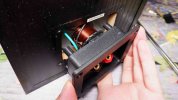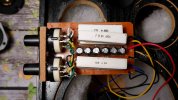@amirm I have a request: Could you measure the sound from the port more thoroughly, please? Just even once, on this or the next ported speaker you measure. I'm most interested in the harmonic distortion that comes from the port, at different sound pressure levels. I'm not sure if it makes a difference for measurement accuracy if the port is near the actual woofer or not, but intuition tells me back ported speaker would be best for examining port noises.
-
WANTED: Happy members who like to discuss audio and other topics related to our interest. Desire to learn and share knowledge of science required. There are many reviews of audio hardware and expert members to help answer your questions. Click here to have your audio equipment measured for free!
You are using an out of date browser. It may not display this or other websites correctly.
You should upgrade or use an alternative browser.
You should upgrade or use an alternative browser.
JBL 4312M II 3-way Studio Monitor Review
- Thread starter amirm
- Start date
restorer-john
Grand Contributor
These are full size - any idea at all how good or not they are?

JBL 4312G Studio Monitor Pair of Speakers Ghost Edition LIMITED OFFER
Buy JBL 4312G Studio Monitor Speakers Ghost Edition in the UK at the best price from authorised JBL dealer. FAST Delivery >> Order Now!www.electricshop.com
A grand in UK terms and for a pair...
That's a great buy.
- Thread Starter
- #223
I already capture the distortion for the port but at only one level. I can start showing that. Here is what it looks like for the 4312m II:@amirm I have a request: Could you measure the sound from the port more thoroughly, please? Just even once, on this or the next ported speaker you measure. I'm most interested in the harmonic distortion that comes from the port, at different sound pressure levels. I'm not sure if it makes a difference for measurement accuracy if the port is near the actual woofer or not, but intuition tells me back ported speaker would be best for examining port noises.
Is this what you looking for?
Yes, exactly this, thank you. I currently have 12 speaker drivers in my home, but none of them are in a ported boxI already capture the distortion for the port but at only one level. I can start showing that. Here is what it looks like for the 4312m II:
View attachment 342068
Is this what you looking for?
So the 2nd and 3rd harmonics are 10-15 dB below fundamental. That makes air a lousy membrane, eh...
fpitas
Master Contributor
Now that I know they're the size of my fist, they just look dumb to me being 3-way with all those drivers.
- Joined
- Jul 31, 2019
- Messages
- 343
- Likes
- 3,137
I have never seen or heard this loudspeaker model, and I've been at HARMAN since 1993. I was curious why, so I did a little bit of investigation and found this out.This is a review, listening tests, EQ and detailed measurements of JBL 4312M II 3-way compact studio monitor (passive speaker). It is on kind loan from a member and I think costs US $1,000 for a pair.
View attachment 340889
Without its ordinary looking grill, the 4312M II definitely has that vintage vibe but with added "beauty" of that white woofer. Those were the days where drivers were positioned to look good. Speaker is a bit heavy for its compact size, which imparts a feeling of quality which its standard box does not impart. Here is the back side:
View attachment 340890
What did the originals have? Screw terminals?
Let's measure it to see if these old ideas of speaker design were any good and whether if any faults have been remedied.
Note: I am the founder of Madrona Digital, a company that specializes in custom installs of electronics in homes and business. We are a dealer for Harman and hence JBL line although I am pretty sure we have never sourced any of these speakers. Objective measurements are as they are but feel free to read bias into my subjective remarks.
If you are new to speaker reviews on ASR, please watch this video understanding speaker measurements.
JBL 4312 MII Speaker Measurements
Let's start with the frequency response measurements of the 4312M II:
View attachment 340891
Story starts pretty good with that smooth response up to 1 kHz and then it looks like a high-school kid with no speaker design experience was told to slap a tweeter and midrange drivers together! What on earth is going on? A clue may be the super messy driver responses:
View attachment 340892
We have so many resonances that I lost count. I don't even know what the midrange is doing (some of it could be bleeding from adjacent driver). Predictably, things don't get better off-axis:
View attachment 340893
Resulting in very odd predicted in-room response:
View attachment 340894
Horizontally placed midrange and tweeter create interference pattern between them as you go off axis in either direction:
View attachment 340895
View attachment 340896
It looks better vertically so perhaps that is the way you want to use them:
View attachment 340897
With uneven frequency response, setting a level for distortion tests was non-trivial. I tried but I think I played them a bit louder than 86 dBSPL:
View attachment 340898
View attachment 340899
At that 86 dBSPL, I could hear the speaker squealing indicating distortion products that we can clearly see, especially those resonances.
Resonances naturally show up in waterfall plot:
View attachment 340900
Impedance shows the same:
View attachment 340901
Even the usually information-free step response shows anomalies:
View attachment 340902
JBL 4312M II Listening Tests and Equalization
I didn't want to listen to the speaker given the seriously poor measurements but decided to do anyway. You would think that the response would make your phone speaker proud but it is not so. It doesn't sound nearly as broken as you would imagine. Why? Because the response is actually pretty good up to 1 kHz. A lot of music spectrum that is important is carried in that region. Alas, those resonances can make the speaker sound bright even though overall treble response is shelved down.
You have to be a masochist to attempt to create an EQ by eye here but I tried anyway:
View attachment 340903
Without the EQ, the sound would quickly become tubby and lacking air (depending on content). And again, bright at times. With EQ, the ambiance around female vocals came back and some of the brightness taken care of with those two notch filters.
Alas, with or without EQ, more than half of my reference tracks were either not pleasurable or sounded annoying. This is just not my idea of a high fidelity speaker. I mean these are extremely well recorded tracks that are used to showcase systems and here, they just don't sound right/good.
Note that due to high sensitivity, I could not get the woofer to distort so playback dynamics was actually quite good for such a small speaker.
Conclusions
My impression of these JBL speakers was that they borrowed the look of the classic speakers but updated the parts/design to make them sound good. Clearly I was mistaken. By any standard, the 4312 M II is broken. I don't know how the marketing person with a straight face chose to call them "studio monitors." Heaven forbid anyone using them to create content!
I can't recommend the JBL 4312M II unless you want to put it on the shelf to just look at to bring back old memories....
------------
As always, questions, comments, recommendations, etc. are welcome.
Any donations are much appreciated using: https://www.audiosciencereview.com/forum/index.php?threads/how-to-support-audio-science-review.8150/
This is a very old model that hasn’t been sold for years. Japan developed it as a miniature version of the 4312 originally in 1996. It was developed by the Japan marketing team and the supplier. The Northridge Engineering team had nothing to do with it. It was only sold in the Japan market until the very end of its production when it was then sold in several other regions including the US. It sold exceptionally well in Japan for many years.
I don't dispute that it measures poorly, but I now know why and the story behind it. Which raises the question: why focus on a speaker that is no longer produced or sold? And why isn't this mentioned up front anywhere in the review? Perhaps, I missed it.
This retired product has no resemblance in sound or measured performance to more recent and current JBL Models engineered in the Northridge Center of Acoustic Excellence. One example is the JBL 4329P which I own along with my Revel Salons 2. . It has textbook measurements based on the current science of how a good speaker should sound and measure. I posted an article about it with measurements below. And there are many other choices available at lower and higher price points that have similar textbook performance.

Sean Olive on LinkedIn: #jbl #audioengineering #loudspeakers | 78 comments
I don't often post about specific products, let alone brag shamelessly about them. But this new JBL 4329P studio monitor is something I am truly excited about… | 78 comments on LinkedIn
 www.linkedin.com
www.linkedin.com
Last edited:
- Joined
- Jan 15, 2020
- Messages
- 7,079
- Likes
- 17,817
Thank you Sean for confirming what I had written some pages before:This is a very old model that hasn’t been sold for years. Japan developed it as a miniature version of the 4312 originally in 1996. It was developed by the Japan marketing team and the supplier. The Northridge Engineering team had nothing to do with it. It was only sold in the Japan market until the very end of its production when it was then sold in several other regions including the US. It sold exceptionally well in Japan for many years.

JBL 4312M II 3-way Studio Monitor Review
Or a DIY bi-amp project. And they made it 3-way for some mysterious reason, considering the tiny woofer. That will keep someone completely frustrated sorting it all out!
 www.audiosciencereview.com
www.audiosciencereview.com
Fully agree, without such information reviews give a sensationalist journalism aftertaste.I don't dispute that it measures poorly, but I now know why and the story behind it. Which raises the question: why focus on a speaker that is no longer produced or sold? And why isn't this mentioned up front anywhere in the review? Perhaps, I missed it.
bennybbbx
Addicted to Fun and Learning
the step response of this JBL show also time align error. You can verify with this test that step response really show usefull time align . measure a speaker with microphone at woofer height at 50 cm distance and another measure at tweeter height or above. in 2. measure the time the signal need from woofer to microphone is longer(in compare to tweeter) as when the microphone is on woofer height. see the screenshot the 2. peak is delayed in compare to woofer height measure . the highlightet is above tweeter height to show it even more. you can see with mic pos at woofer height the 2. peak is more near first peak. this diffrence can set in a delay of a active crossover and so can get good time align

Last edited:
I think the horse is dead.
kemmler3D
Master Contributor
Aha, I was right, there WERE two different teams involved. Well, I guess that's no big surprise since it's hard to imagine the same folks putting out stuff like the 4329 and this.This is a very old model that hasn’t been sold for years. Japan developed it as a miniature version of the 4312 originally in 1996. It was developed by the Japan marketing team and the supplier. The Northridge Engineering team had nothing to do with it
May I ask, are all current speakers engineered in Northridge or are there JBL speakers still created in Japan? For example, are the 4312G speakers a product of Northridge?This retired product has no resemblance in sound or measured performance to more recent and current JBL Models engineered in the Northridge Center of Acoustic Excellence.
Tom C
Major Contributor
I’m starting to think all the cool kids have a pair of Salons, plus a pair of two-way JBL’s.
- Joined
- Jul 31, 2019
- Messages
- 343
- Likes
- 3,137
All of the JBL and Revel home speakers are designed in Northridge. Only the less expensive Bluetooth portable speakers are designed by the Harman engineering team in Shenzhen like the JBL Flip and Party Box speakers for example.May I ask, are all current speakers engineered in Northridge or are there JBL speakers still created in Japan? For example, are the 4312G speakers a product of Northridge?
musicforcities
Senior Member
- Joined
- Sep 18, 2021
- Messages
- 470
- Likes
- 545
That is one ugly looking speaker with even uglier frequency response curves.
D
Deleted member 48726
Guest
Some Cerwin Vega models also run the bass driver full range.View attachment 341003
Not only is the L100 woofer full range, the mid and high networks consist of a cap and an L-pad each! Amazing.
The idea of using a woofer without a low pass is not without precedent, and it is elegant in a certain sense. If the woofer is naturally well damped, you can get a first order slope without much breakup, and you have the added advantage that the DI is smooth all the way up through the treble owing to the fact that the only thing changing directivity is the beaming of the woofer, which in an ideal scenario is smooth and predictable. The mid is more of a 'coupling' driver, a low tweeter, essentially, and the tweeter can be built to only deal with the tippy top octave.
The spendor BC1 works that way:
View attachment 341004
Troels Gravesen has a great discussion on this speaker and the L100.
You can learn a lot from old speakers. ASR is too harsh on the designers of these systems.
Of course if you want a high efficiency paper woofer with super extended HF, breakup is inevitable, which is how you get the JBL situation.
CamilleScholtz
New Member
- Joined
- Oct 17, 2024
- Messages
- 3
- Likes
- 0
So I have these speakers, and whilst the measurements might be bad, I am really in love with the looks. I'm considering upgrading the crossover, but I never did something like this. Could anyone give me some pointers?
These are some pictures I found on a Japanese blog of the crossover. I am planning on just doing away with the attenuator.



The current crossover points are 7kHz and 12kHz, which seem awfully high, though I have to admit I don't know anything about crossovers or audio really, I am a complete noob. Should these be lowered?
These are some pictures I found on a Japanese blog of the crossover. I am planning on just doing away with the attenuator.



The current crossover points are 7kHz and 12kHz, which seem awfully high, though I have to admit I don't know anything about crossovers or audio really, I am a complete noob. Should these be lowered?
Similar threads
- Replies
- 37
- Views
- 17K
- Replies
- 1
- Views
- 632
- Replies
- 0
- Views
- 231
- Poll
- Replies
- 8
- Views
- 2K
- Poll
- Replies
- 66
- Views
- 17K
